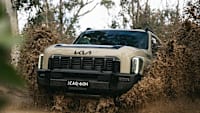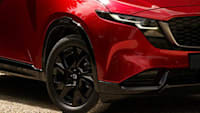Porsche has given its Cayenne SUV a thorough going over, with a refreshed design, tweaked engine choices and big uptick in in-car tech.
Available to order now ahead of deliveries starting in the third quarter, the update is the biggest change to the Cayenne since the launch of the third-generation version in Australia in mid-2018.
Porsche is expected to continue to sell the current Cayenne well into the future ahead of a full change to an all-electric Cayenne in about 2026.
-
More than a facelift: 2024 Porsche Cayenne revealed in preview ahead of official debut
-
Confirmed! 2026 Porsche Cayenne electric car to follow Macan, before 718 sports car and new large SUV go electric
-
Tesla Model X who? 2026 Porsche Cayenne electric car in the works to bring the heat to electric SUVs
In the meantime, the revised version cops a price increase across the range as part of the update. The price rises range from $2100 for the E-Hybrid Coupe to a hefty $14,300 for the flagship Turbo GT Coupe.
The entry grade, which is just called Cayenne, kicks off the range at $140,200 before on-road costs, now $5900 dearer than before, while the Cayenne Coupe is up $3100 to $148,200.
Lined up against its key rivals, the Cayenne is only slightly pricier from the entry grade. The cheapest petrol Mercedes-Benz GLE, the 450, costs $135,200 before on-road costs, while the BMW X5 xDrive40i starts at $138,900.
So what has Porsche changed for the update?
The front end gets a more aggressive look, with a new more contoured bonnet, restyled grille, tweaked headlight signature and redone lower apron. All Cayennes come standard with Matrix LED headlights, while high-definition Matrix LEDs with an anti-dazzle function are optional.
.jpg)
At the rear, there is a new rear apron with integrated number plate holder, and new streamlined three-dimensional tail-lights that are the same size across the entire tailgate.
Three new colours have joined the palette and wheels range in size from 20 to 22 inches, depending on the grade.
Suspension gets a tweak with steel sprint setup including Porsche’s Active Suspension Management (PASM) active damping system, and new shock absorbers making for improved low-speed ride comfort. Optional adaptive air suspension makes for an even softer ride, according to the German brand.
.jpg)
Inside, the company has introduced the ‘Porsche Driver Experience’ concept from the Taycan performance EV into the new Cayenne. Porsche says it “focuses on the driver's axis and optimises operation”. Functions that are frequently used are placed closer to the steering wheel.
The automatic transmission shifter moves from the console to the dash to make more room for storage and for a large air conditioning control panel.
The refreshed cabin gains a 12.6-inch digital cluster with a curved display paired with a 12.3-inch multimedia setup. There’s also an optional 10.9-inch display for the passenger side, similar to that of the Taycan.
.jpg)
Engines include a carryover 3.0-litre V6 petrol for the base car that gets a 10kW/50Nm boost to 260kW/500Nm. The Cayenne S swaps out the turbocharged V6 for Porsche’s updated 4.0-litre V8, delivering 349kW/600Nm - which is 25kW/50Nm more than the outgoing engine.
The E-Hybrid gets a boost in power for the electric motor (+30kW) and now outputs a total of 346kW when combined with the six-cylinder petrol engine. It gets a boost in battery capacity from 17.9kWh to 25.9kWh, while an 11kW onboard charger reduces charging times.
The flagship Turbo GT gets an extra 14kW and so the V8 now pumps out 485kW for a 3.3-second 0-100km/h dash time.
2023 Porsche Cayenne pricing before on-road costs
| Variant | Transmission | Price |
| Cayenne | Automatic | $140,200 (+$5900) |
| Cayenne Coupe | Automatic | $148,200 (+$3100) |
| E-Hybrid | Automatic | $155,900 (+$5000) |
| E-Hybrid Coupe | Automatic | $161,600 (+$2100) |
| S | Automatic | $181,000 (+$5700) |
| S Coupe | Automatic | $190,000 (+$5000) |
| Turbo GT | Automatic | $366,200 (+$14,300) |








.jpg)







.jpg)



.jpg)
.jpg)
.jpg)

.jpg)


.jpg)

